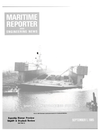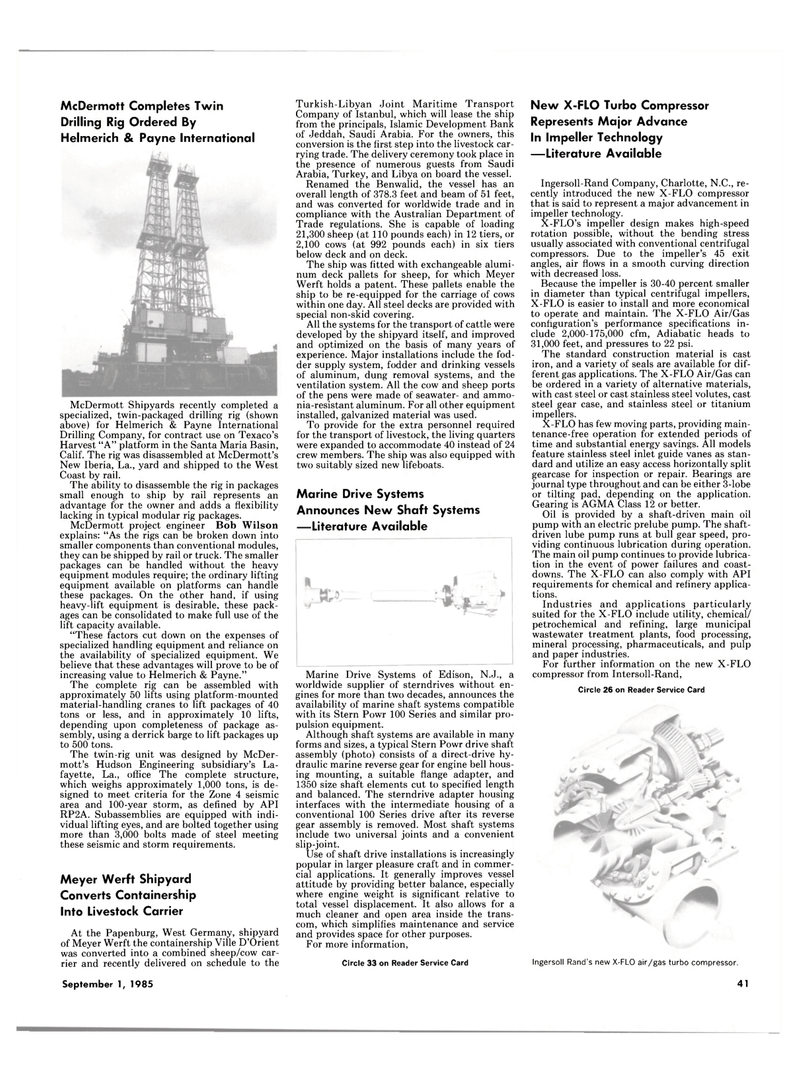
Page 41: of Maritime Reporter Magazine (September 1985)
Read this page in Pdf, Flash or Html5 edition of September 1985 Maritime Reporter Magazine
McDermott Completes Twin
Drilling Rig Ordered By
Helmerich & Payne International
McDermott Shipyards recently completed a specialized, twin-packaged drilling rig (shown above) for Helmerich & Payne International
Drilling Company, for contract use on Texaco's
Harvest "A" platform in the Santa Maria Basin,
Calif. The rig was disassembled at McDermott's
New Iberia, La., yard and shipped to the West
Coast by rail.
The ability to disassemble the rig in packages small enough to ship by rail represents an advantage for the owner and adds a flexibility lacking in typical modular rig packages.
McDermott project engineer Bob Wilson explains: "As the rigs can be broken down into smaller components than conventional modules, they can be shipped by rail or truck. The smaller packages can be handled without the heavy equipment modules require; the ordinary lifting equipment available on platforms can handle these packages. On the other hand, if using heavy-lift equipment is desirable, these pack- ages can be consolidated to make full use of the lift capacity available. "These factors cut down on the expenses of specialized handling equipment and reliance on the availability of specialized equipment. We believe that these advantages will prove to be of increasing value to Helmerich & Payne."
The complete rig can be assembled with approximately 50 lifts using platform-mounted material-handling cranes to lift packages of 40 tons or less, and in approximately 10 lifts, depending upon completeness of package as- sembly, using a derrick barge to lift packages up to 500 tons.
The twin-rig unit was designed by McDer- mott's Hudson Engineering subsidiary's La- fayette, La., office The complete structure, which weighs approximately 1,000 tons, is de- signed to meet criteria for the Zone 4 seismic area and 100-year storm, as defined by API
RP2A. Subassemblies are equipped with indi- vidual lifting eyes, and are bolted together using more than 3,000 bolts made of steel meeting these seismic and storm requirements.
Meyer Werft Shipyard
Converts Containership
Into Livestock Carrier
At the Papenburg, West Germany, shipyard of Meyer Werft the containership Ville D'Orient was converted into a combined sheep/cow car- rier and recently delivered on schedule to the
Turkish-Libyan Joint Maritime Transport
Company of Istanbul, which will lease the ship from the principals, Islamic Development Bank of Jeddah, Saudi Arabia. For the owners, this conversion is the first step into the livestock car- rying trade. The delivery ceremony took place in the presence of numerous guests from Saudi
Arabia, Turkey, and Libya on board the vessel.
Renamed the Benwalid, the vessel has an overall length of 378.3 feet and beam of 51 feet, and was converted for worldwide trade and in compliance with the Australian Department of
Trade regulations. She is capable of loading 21,300 sheep (at 110 pounds each) in 12 tiers, or 2,100 cows (at 992 pounds each) in six tiers below deck and on deck.
The ship was fitted with exchangeable alumi- num deck pallets for sheep, for which Meyer
Werft holds a patent. These pallets enable the ship to be re-equipped for the carriage of cows within one day. All steel decks are provided with special non-skid covering.
All the systems for the transport of cattle were developed by the shipyard itself, and improved and optimized on the basis of many years of experience. Major installations include the fod- der supply system, fodder and drinking vessels of aluminum, dung removal systems, and the ventilation system. All the cow and sheep ports of the pens were made of seawater- and ammo- nia-resistant aluminum. For all other equipment installed, galvanized material was used.
To provide for the extra personnel required for the transport of livestock, the living quarters were expanded to accommodate 40 instead of 24 crew members. The ship was also equipped with two suitably sized new lifeboats.
Marine Drive Systems
Announces New Shaft Systems —Literature Available
Marine Drive Systems of Edison, N.J., a worldwide supplier of sterndrives without en- gines for more than two decades, announces the availability of marine shaft systems compatible with its Stern Powr 100 Series and similar pro- pulsion equipment.
Although shaft systems are available in many forms and sizes, a typical Stern Powr drive shaft assembly (photo) consists of a direct-drive hy- draulic marine reverse gear for engine bell hous- ing mounting, a suitable flange adapter, and 1350 size shaft elements cut to specified length and balanced. The sterndrive adapter housing interfaces with the intermediate housing of a conventional 100 Series drive after its reverse gear assembly is removed. Most shaft systems include two universal joints and a convenient slip-joint.
Use of shaft drive installations is increasingly popular in larger pleasure craft and in commer- cial applications. It generally improves vessel attitude by providing better balance, especially where engine weight is significant relative to total vessel displacement. It also allows for a much cleaner and open area inside the trans- com, which simplifies maintenance and service and provides space for other purposes.
For more information,
Circle 33 on Reader Service Card
New X-FLO Turbo Compressor
Represents Major Advance
In Impeller Technology —Literature Available
Ingersoll-Rand Company, Charlotte, N.C., re- cently introduced the new X-FLO compressor that is said to represent a major advancement in impeller technology.
X-FLO's impeller design makes high-speed rotation possible, without the bending stress usually associated with conventional centrifugal compressors. Due to the impeller's 45 exit angles, air flows in a smooth curving direction with decreased loss.
Because the impeller is 30-40 percent smaller in diameter than typical centrifugal impellers,
X-FLO is easier to install and more economical to operate and maintain. The X-FLO Air/Gas configuration's performance specifications in- clude 2,000-175,000 cfm, Adiabatic heads to 31,000 feet, and pressures to 22 psi.
The standard construction material is cast iron, and a variety of seals are available for dif- ferent gas applications. The X-FLO Air/Gas can be ordered in a variety of alternative materials, with cast steel or cast stainless steel volutes, cast steel gear case, and stainless steel or titanium impellers.
X-FLO has few moving parts, providing main- tenance-free operation for extended periods of time and substantial energy savings. All models feature stainless steel inlet guide vanes as stan- dard and utilize an easy access horizontally split gearcase for inspection or repair. Bearings are journal type throughout and can be either 3-lobe or tilting pad, depending on the application.
Gearing is AGMA Class 12 or better.
Oil is provided by a shaft-driven main oil pump with an electric prelube pump. The shaft- driven lube pump runs at bull gear speed, pro- viding continuous lubrication during operation.
The main oil pump continues to provide lubrica- tion in the event of power failures and coast- downs. The X-FLO can also comply with API requirements for chemical and refinery applica- tions.
Industries and applications particularly suited for the X-FLO include utility, chemical/ petrochemical and refining, large municipal wastewater treatment plants, food processing, mineral processing, pharmaceuticals, and pulp and paper industries.
For further information on the new X-FLO compressor from Intersoll-Rand,
Circle 26 on Reader Service Card
Ingersoll Rand's new X-FLO air/gas turbo compressor.
September 1, 1985 41

 40
40

 42
42
